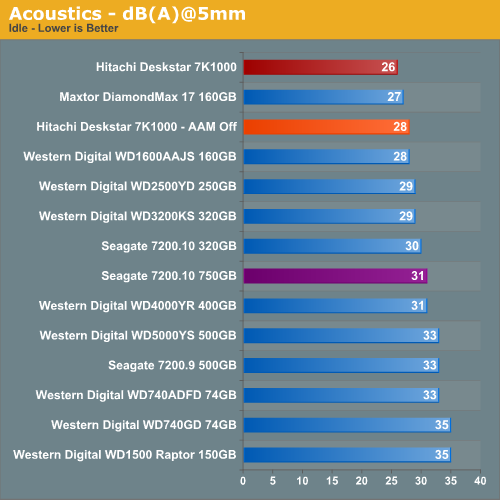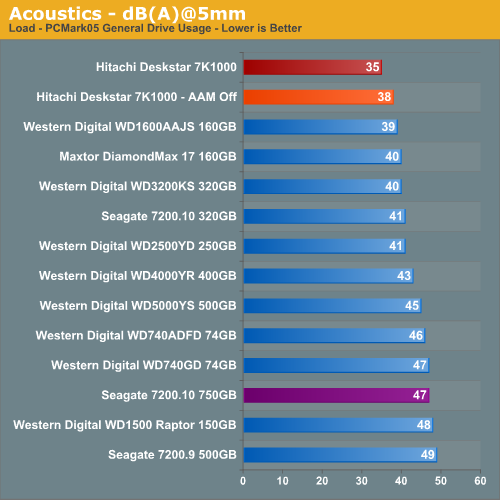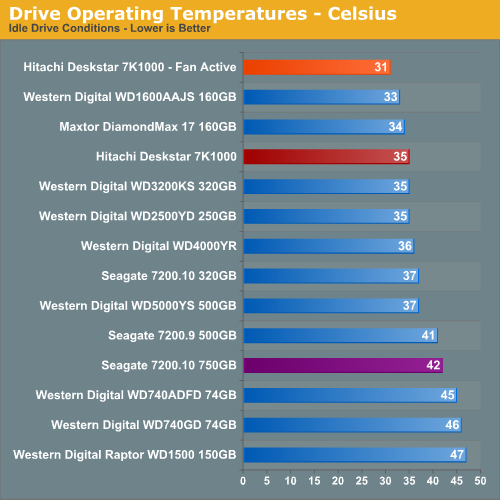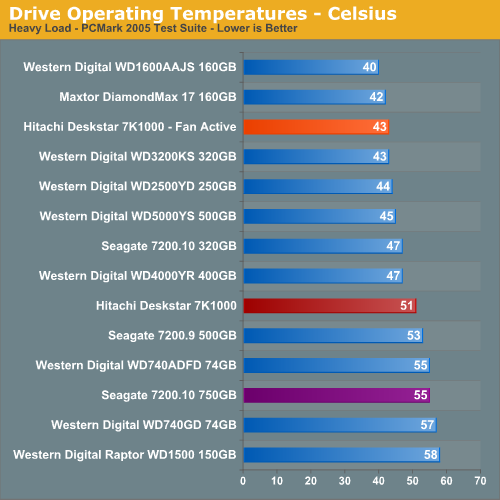Hitachi Deskstar 7K1000: Terabyte Storage arrives on the Desktop
by Gary Key on March 19, 2007 8:00 AM EST- Posted in
- Storage
Hard Drive Performance: Acoustics
Our acoustic test utilizes our standard test bed components but we implement AMD's Cool'n'Quiet technology and turn off the case fans to isolate as much case noise as possible during testing. Our OCZ power supply is nearly silent in these tests and our fanless ASUS 7600GS video card provides a further decrease in our case's ambient noise levels. Our drives are attached to the drive cage with rubber bushings to assist in isolating the noise of the drive without resulting harmonic changes due to the case design
Our acoustic tests are designed to measure the decibel levels while the system is at idle and also under load while running the General Hard Disk Drive Usage benchmark within PCMark 2005. We found through trail and error that this particular benchmark produces controlled readings across a wide range of applications within the benchmark. This particular benchmark utilizes 60% reads and 40% writes within the trace playback file.
The measurements are taken at a distance of 5 millimeters from the rear and front of the drive being tested in order to minimize surrounding environmental noise. We take our measurements over a period of twenty minutes, so idle measurements will include operating system interrupt and polling routines. We have noticed that unless we run a silent system in a near silent room that measurements taken from 1 meter are generally not meaningful due to ambient noise levels. There are exceptions like the Raptor series of drives but overall most modern desktop drives are quieter now than the other components in the system.
The reported measurements are based on an A-weighted decibel score that measures frequencies similar to the way the human ear responds to sound. We take a total of three measurements for each test. We then subtract the high and low scores and arrive at our findings by reporting the remaining score.


Our Hitachi Deskstar 7K1000 is the quietest drive that we have ever tested. We basically could not hear the drive and at times wondered if it was operating with AAM turned on. Even with AAM turned off, the drive was extremely quiet at idle and under load where it still scored better than our other test units. Our subjective opinion with AAM turned off is that the seek requests are muted greatly but still noticeable when compared to the other drives. The only other significant audible noise is a slight whirling sound as the drive spins up on a cold start or after a reboot. We just cannot emphasize enough how quiet this drive is in our test configuration with AAM enabled at the 128 setting. We even removed the rubber mounting grommets in our drive cage and did not notice any differences in acoustics or vibration levels. Our base dB(A) level in the room at time of testing was 25 dB(A).
Hard Drive Performance: Thermals
Our thermal tests utilize sensor readings via the S.M.A.R.T. (Self-Monitoring, Analysis and Reporting Technology) capability of the drives and are reported by utilizing the Active SMART 2.42 utility. We test our drives in an enclosed case environment without the front fan operational to simulate temperatures that could conceivably be reached in a SFF or HTPC case design. We typically find the reported numbers drop anywhere from 18% to 25% on average when the front fan is operational.
We typically let the drive idle for fifteen minutes before starting our idle thermal testing. Our load testing consists of taking the high temperature reading after looping the PCMark 2005 HD Suite benchmark five times. We also check load temps after looping our Nero Recode encoding test three times.


We expected the 7K1000 to run as warm as the Seagate 750GB due to the five platter design. However, under both idle and load conditions it operated significantly cooler than Seagate's large capacity PMR design. We have additional power and thermal management tests to run but at this time we were pleasantly surprised with the results. The load temperatures dropped from 51C to 43C and idle temps dropped from 35C to 31C with our front case fan operational. We highly recommend a fan be installed near the drive during normal operation. Our test room temperatures were 24C during these tests.
Our acoustic test utilizes our standard test bed components but we implement AMD's Cool'n'Quiet technology and turn off the case fans to isolate as much case noise as possible during testing. Our OCZ power supply is nearly silent in these tests and our fanless ASUS 7600GS video card provides a further decrease in our case's ambient noise levels. Our drives are attached to the drive cage with rubber bushings to assist in isolating the noise of the drive without resulting harmonic changes due to the case design
Our acoustic tests are designed to measure the decibel levels while the system is at idle and also under load while running the General Hard Disk Drive Usage benchmark within PCMark 2005. We found through trail and error that this particular benchmark produces controlled readings across a wide range of applications within the benchmark. This particular benchmark utilizes 60% reads and 40% writes within the trace playback file.
The measurements are taken at a distance of 5 millimeters from the rear and front of the drive being tested in order to minimize surrounding environmental noise. We take our measurements over a period of twenty minutes, so idle measurements will include operating system interrupt and polling routines. We have noticed that unless we run a silent system in a near silent room that measurements taken from 1 meter are generally not meaningful due to ambient noise levels. There are exceptions like the Raptor series of drives but overall most modern desktop drives are quieter now than the other components in the system.
The reported measurements are based on an A-weighted decibel score that measures frequencies similar to the way the human ear responds to sound. We take a total of three measurements for each test. We then subtract the high and low scores and arrive at our findings by reporting the remaining score.


Our Hitachi Deskstar 7K1000 is the quietest drive that we have ever tested. We basically could not hear the drive and at times wondered if it was operating with AAM turned on. Even with AAM turned off, the drive was extremely quiet at idle and under load where it still scored better than our other test units. Our subjective opinion with AAM turned off is that the seek requests are muted greatly but still noticeable when compared to the other drives. The only other significant audible noise is a slight whirling sound as the drive spins up on a cold start or after a reboot. We just cannot emphasize enough how quiet this drive is in our test configuration with AAM enabled at the 128 setting. We even removed the rubber mounting grommets in our drive cage and did not notice any differences in acoustics or vibration levels. Our base dB(A) level in the room at time of testing was 25 dB(A).
Hard Drive Performance: Thermals
Our thermal tests utilize sensor readings via the S.M.A.R.T. (Self-Monitoring, Analysis and Reporting Technology) capability of the drives and are reported by utilizing the Active SMART 2.42 utility. We test our drives in an enclosed case environment without the front fan operational to simulate temperatures that could conceivably be reached in a SFF or HTPC case design. We typically find the reported numbers drop anywhere from 18% to 25% on average when the front fan is operational.
We typically let the drive idle for fifteen minutes before starting our idle thermal testing. Our load testing consists of taking the high temperature reading after looping the PCMark 2005 HD Suite benchmark five times. We also check load temps after looping our Nero Recode encoding test three times.


We expected the 7K1000 to run as warm as the Seagate 750GB due to the five platter design. However, under both idle and load conditions it operated significantly cooler than Seagate's large capacity PMR design. We have additional power and thermal management tests to run but at this time we were pleasantly surprised with the results. The load temperatures dropped from 51C to 43C and idle temps dropped from 35C to 31C with our front case fan operational. We highly recommend a fan be installed near the drive during normal operation. Our test room temperatures were 24C during these tests.










74 Comments
View All Comments
phusg - Tuesday, March 20, 2007 - link
I think you are right, but don't forget that in this post you are only looking at it from a performance viewpoint. Drive longevity and acoustics are major factors to me, and I think for you too from the article. I think these are the metrics worth looking at and tend to agree that subjective performance doesn't really differentiate that much (although I haven't had half as much experience with different vendors/models as you have).gramboh - Monday, March 19, 2007 - link
I read the review earlier this morning but don't recall seeing anything about retail channel availability. Did Hitachi or Dell comment to AT about this?I'm actually interested in 500GB 7200.10's and hoping this release will push the price of those down a lot.
Gary Key - Monday, March 19, 2007 - link
We do not have an exact date. Hitachi committed to having product into the retail channel by the end of Q1. We should have an answer from Dell tomorrow on when they will offer it outside of their systems. Hitachi is saying the drive will launch at $399, just waiting to see $550 price tags when the first drives show up... ;)Jeff7181 - Monday, March 19, 2007 - link
This might find it's way into my computer later this year. :)BUL - Monday, March 19, 2007 - link
Interesting that perpendicular technology was chosen given the R&D costs (with the tiny return of ~5 years before obsolescence--the article mentions that perpendicular can ONLY go 5x denser with existing techology & figure we'll see 5TB perpendicular drives in 2 years), etc... So why don't manufacturers offer 5 1/4" drives? Not to invoke memories of the MFM drives of long-ago (the original XT had a double-size 5 1/4" MFM drive of 10MB), but they have potentially 50-60% more surface area per platter, and with a possibility of 7(?) platters, isn't that a better solution? True, you wouldn't put them in SFFs or notebooks, but how many of us have towers with empty 5 1/4" bays??? And I assume that a 1TB 5 1/4" drive would be more energy-efficient than two 500GB 3 1/2" drives...Also, has anyone REALLY tested to see if perpendicular is truly a reliable technology? Seems like manufacturers have 50 years of experience with parallel storage, and only 1-2 years using perpendicular storage...
Spoelie - Tuesday, March 20, 2007 - link
Bulkier, slower, less energy efficient and more moving parts that reduce reliability all in the name of increased capacity is not the way to the future. I think the biggest problem at the moment is NOT storage capacity, they're mostly increasing capacity to keep HDs evolving and not drop in price, as it's one of the only competitive advantages. If you can increase capacity with the same material cost and some extra R&D, it would be stupid not to do it, and a better way than increasing the material cost.In fact, regular folk have way too much capacity at the moment. A Seagate CEO worded it nicely a while back "Face it, we're not changing the world. All we do is enable people to store more crap/porn."
The future lies in the direction of flash based hard drives: smaller, less/no moving parts instead of more, faster access times, lower energy consumption/heat. Or other alternative technologies that offer the same advantages. The densities and cost are the only reasons we're not all buying them at the moment, something that should be fixed over time.
If you're worried about unused case slots, buy one of those things that enable you to install normal hard drives in it, or convince the case designers to include more 3 1/2" slots and less 5 1/4" slots.
misuspita - Monday, March 19, 2007 - link
Have you ever seen a slow motion filming of a cd-rom disk wobbling? Same thing here! I think the platters got smaller because the vibrations produced by them grew with the speed. Since today's r/w heads need to be extremely close to the surface, that would be utterly impossible to control at that speed and diameter. They changed also from an aluminum based disk to an glass based one also, because the roughness of the surface on the Al platter.tygrus - Monday, March 19, 2007 - link
It's harder to spin a large diametter platter at high speed. More weight, more wobble, slower access times. I saw once a 5.25" 4x2.5" SATA drive array. Quantum used to do a large format BigFoot for cheap, slow large capacity but it wasn't continued. We have plenty of capacity per platter but limited perf/GB (worse every year) so why decrease performance to increase capacity ?piroroadkill - Monday, March 19, 2007 - link
All of the Seagate Barracuda 7200.10 drives have been perpendicular for some time..It seems like a perfectly reliable tech to me
Olaf van der Spek - Monday, March 19, 2007 - link
How smart is it to use temperatures from SMART?Did you verify all HDDs use good quality unbiased temperature sensors?
> Our thermal tests utilize sensor readings via the S.M.A.R.T. (Self-Monitoring, Analysis and Reporting Technology) capability of the drives and are reported by utilizing the Active SMART 2.42 utility.